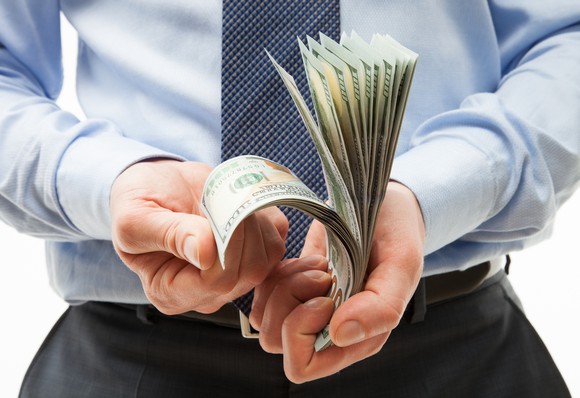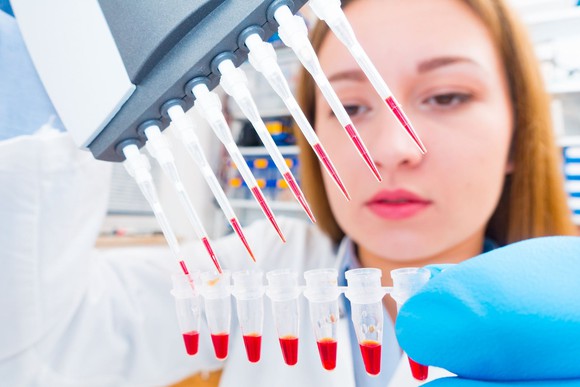
Image source: Getty Images.
More often than not, dividend stocks are what form the foundation of any great retirement portfolio. Not only have dividend stocks handily outperformed non-dividend-paying stocks over the long run, but they also offer a number of other advantages that income investors are bound to like.
To begin with, dividend-paying companies often have time-tested business models. A business is unlikely to pay a recurring dividend to investors if its management team didn't believe profits would grow in the future. Thus, dividend stocks are often a beacon of profitability and stability that attract income seekers.
Dividend stocks also help to hedge against inevitable stock market corrections -- there have been 35 stock market corrections of at least 10% since 1950 in the S&P 500 -- and payouts can be reinvested back into more shares of stock via a Dividend Reinvestment Plan, or DRIP. Purchasing more shares of dividend-paying stock with your payout in a repeating cycle can help your nest egg quickly compound in value over time.
Unfortunately, dividend stocks can also harbor a dark side. Income seekers would like the highest dividend yield possible, but they also have to ensure that a payout is sustainable. Dividend yields are a function of a stock's price, meaning a plunging stock price can dramatically lift dividend yields, making them seem attractive, at least on the surface. But, as we know, a plunging stock price could signify a business model that's in trouble. Thus, high-yield dividends, or those with yields of 4% or higher, should be heavily scrutinized by investors.
The good news is there are a number of top high-yield dividends that income seekers can consider buying in 2017. Here are three to add to your list.

Image source: Seagate Technology.
Seagate Technology PLC
Earlier this year, storage solutions company Seagate Technology (STX +0.00%) was a strong candidate to cut its dividend. Seagate has struggled with the transition to cloud-computing, and while it's been focusing on its next-generation solid-state drives (SSD), growth in this category hasn't been able to outpace losses in revenue from traditional hard-disk drives (HDD).
However, Seagate may be in better shape than Wall Street is giving the company credit for. For instance, even though HDD revenue has fallen in each of the past four years, Wall Street could be overlooking the enormous data storage demands of big data centers. Companies are increasingly turning to the cloud and data centers to streamline their business, and that should help form a solid foundation for HDDs, even if Seagate's pricing power for HDDs is down and competition in the space is fierce.
Along those same lines, we're also seeing a strong push toward enterprise reliance. This isn't to say Seagate doesn't thrive outside of its enterprise consumers, but enterprise demand is where its greatest current growth opportunity lies in both HDD and SSD. During its fiscal first quarter report for 2017, Seagate announced that 41% of its revenue was derived from enterprise customers, which is up from 30% in the first quarter of 2015. It also shipped its highest level of HDD Exabyte capacity for any quarter over the past two years. So even though its volume of HDD units being shipped is down notable from two years ago, enterprise demand is still very much alive for HDDs.
Finally, Seagate continues to do an admirable job of sharing the wealth. It's spent nearly $2.3 billion over the past nine quarters to repurchase its own common stock, and has returned nearly $1.3 billion via dividend in aggregate between fiscal 2015 and 2016. The company's current yield of 6.5% appears sustainable given the nearly $6 in free cash flow per share expected by Wall Street in 2017, making Seagate a worthwhile top high-yield dividend stock to consider.

Image source: Getty Images.
AbbVie Inc.
Healthcare isn't exactly a sector income seekers typically flock to considering that most drug and device developers aren't profitable. Even those that are usually reinvest a substantial portion of their cash flow back into marketing and research and development. Of course, AbbVie (ABBV +1.80%) isn't your traditional drug company.
There's little denying the prime selling point of AbbVie -- anti-inflammatory drug Humira. Of the $18.8 billion in sales AbbVie has registered through the first nine months of 2016, Humira is responsible for $11.8 billion. Currently on pace for nearly $16 billion in annual sales, Humira is the best-selling drug in the world, and it's about to turn in the best year ever for a pharmaceutical product by sales. Humira has 10 Food and Drug Administration-approved indications, and while there's concern that biosimilar competition could begin chipping away at Humira's dominance toward the end of the decade, for now it continues to deliver in a big way for AbbVie and investors.
Beyond Humira, AbbVie has two key building blocks: blood cancer drug Imbruvica and its growing hepatitis C portfolio. Imbruvica is a blockbuster cancer drug acquired when AbbVie purchased Pharmacyclics in 2015. It's already generated more than $1.3 billion through nine months for AbbVie, and this doesn't even factor in that a sizable chunk of Imbruvica's revenue goes to Johnson & Johnson, which was Pharmacyclics' licensing partner on the drug.
Within just the past few days, AbbVie filed a new drug application for pan-genotypic regimen of glecaprevir and pibrentasvir, known as G/P for short. In clinical studies, G/P led to a sustained virologic response in 97.5% of patients who were treatment-naïve and without liver cirrhosis. When combined with Viekira, which is already on pharmacy shelves, AbbVie could have a multi-billion dollar HCV product portfolio.
Sporting a 4.1% yield and a well-below-average forward P/E, AbbVie is certainly worth a closer look.

Image source: Getty Images.
Royal Dutch Shell PLC
A final top high-yield dividend stock worthy of your consideration is integrated oil and gas giant Royal Dutch Shell (NYSE: RDS-A)(NYSE: RDS-B).
The big knock against big oil in recent years has been the precipitous drop in crude prices. Even with a steady rebound in 2016, crude is still about 50% lower than where it was three years ago, and that can take a big bite out of oil giants like Royal Dutch Shell. A smaller issue is the company's acquisition of BG Group for $53 billion, which ballooned its net debt to nearly $77 billion as of the end of the latest quarter. Even though interest rates have been low and conducive to M&A, carrying around so much debt has clearly spooked investors a bit.
Now for a bit of good news: Shell's purchase of BG Group is going to transform the company in a very positive and meaningful way. BG Group has abundant natural gas and natural gas liquid assets, which instantly makes Shell one of the largest gas players in the world. Even though natural gas prices have been hit right along with crude in recent years, governments in developed countries are pushing for cleaner-burning fuels. This would imply that natural gas has a more favorable long-term outlook than coal, for example. Furthermore, the BG Group deal should boost production by 20% annually, while also giving the combined entity up to $4.5 billion in annual cost synergies. In short, we're talking about improved cash flow and margins once this deal is completely digested.
Royal Dutch Shell has also done an exemplary job of controlling its costs to boost margins and preserve its 7% dividend yield, which, at one point earlier this year, looked to be in danger of being cut. Capital expenditures are expected to be between $25 billion and $30 billion in 2016 after coming in at $60 billion in 2013. By more wisely picking and choose its projects, Royal Dutch Shell is demonstrating that less can indeed be more.
Assuming we've put a floor in for both crude and natural gas, Royal Dutch Shell could be a surprisingly strong income play for investors in 2017.
